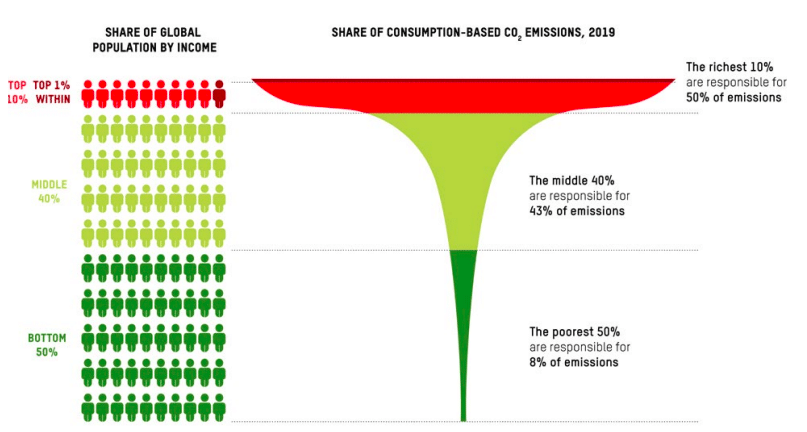The new Oxfam study proposes a tax of 60% on the incomes of the richest 1% globally, saying it would not only reduce their carbon footprint but also generate approximately US$6.4 trillion, which could be used to fund the urgently needed transition to clean energy.
—
The emissions of the wealthiest 1% in 2019 were equivalent to those of the poorest 66% of humanity, approximately 5 billion people, and were sufficient to cause 1.3 million deaths due to heat-related illnesses, new research has found.
The new study, published Monday by Oxfam, a global organisation that fights inequality to end poverty and injustice, has shed light on the alarming carbon emissions of the super-rich, revealing their disproportionate contribution to global climate change and underscoring the urgent need to address the excessive carbon consumption of the affluent minority.

Oxfam’s findings come just weeks after a study warned that the world is running out of its carbon budget, the net amount of carbon dioxide (CO2) we have left to emit before we exceed the 1.5C warming threshold. Specifically, new data indicates that, at current emissions levels, we have just six years left for a 50-50 chance to reach the 1.5C limit.
According to Oxfam, between 1990 and 2019, the richest 1% depleted 12% of the world’s carbon budget, while the bottom 50% by income used just 5%. Moreover, if current trends continue, emissions of the super-rich 1% – most coming from people living in China and the Gulf countries and about one-third associated with the consumption of people based in the US – are projected to surpass the safe limit by over 22 times in 2030. These alarming statistics highlight the grave consequences of unchecked carbon emissions and the urgent need to rein in the excessive footprint of the wealthiest individuals.
The disproportionate impact of the so-called “polluting elite” on the environment has been subject of extensive debate in recent years. A UN-backed report published earlier this year had already raised the alarm, suggesting that the top 10% of the world’s population are responsible for almost half of the annual carbon emissions and the global top 1% of emitters generate more emissions than the entire bottom half. According to the study, reducing carbon consumption at the top level would free up the carbon budget required to eradicate poverty below the US$5.50/day poverty line, meaning the poorest in the world would be able to increase their greenhouse gas emissions needed to reach prosperity.
This inequality, Oxfam argues, could be tackled by taxing the rich – a move that would bring a “significant portion of this excessive wealth and profit back into public hands.” Specifically, introducing a wealth tax, a top income tax, and a windfall corporate profits tax would be enough to raise more than US$9 trillion, a huge amount that could be reinvested in green infrastructure and programmes to fight poverty and inequality in the world, according to Oxfam’s calculations.
“Not taxing wealth allows the richest to rob from us, ruin our planet and renege on democracy,” said Oxfam International’s interim executive director, Amitabh Behar. “Taxing extreme wealth transforms our chances to tackle both inequality and the climate crisis. These are trillions of dollars at stake to invest in dynamic 21st-century green governments, but also to re-inject into our democracies.”
The huge inequality gap has long existed between countries, too. For decades, experts have warned of the disproportionate impact of wealthy nations on the planet. In 2019, high-income countries, representing only 16% of the global population, accounted for 40% of the CO2 emissions resulting from consumption-based activities. In contrast, low-income countries made a minimal contribution of just 0.4%. Africa, for example, home to 17% of the world’s population, was responsible for less than 4% of global consumption-based emissions.
“For years we’ve fought to end the era of fossil fuels to save millions of lives and our planet. It’s clearer than ever this will be impossible until we, too, end the era of extreme wealth,” said Behar.
You might also like: Wealthy Nations May Have Met $100 Billion Climate Finance Pledge in 2022, OECD Says


















